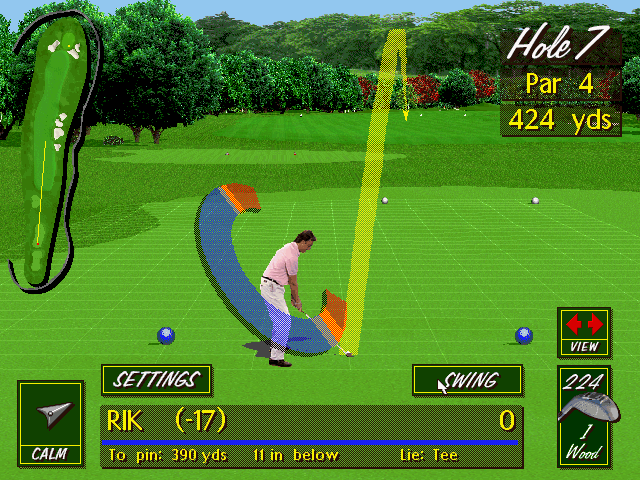
PGA Tour Golf 486
Written by: Rik
Date posted: May 28, 2018
- Genre: Sport
- Developed by: Hitmen Productions
- Published by: Electronic Arts
- Year released: 1994
- Our score: 6
A peculiarity of 90s gaming was that a combination of impressive visuals and high scores from the games press would be able to encourage otherwise extremely unlikely purchases. I’ll admit to being more gullible than most, but at the same time, I’d wager that most gamers with a PC in the mid-90s will have owned a flight sim and/or golf game despite having no interest in, respectively, flying planes or playing golf. Still, they provided something to dig out and show off to Amiga or console owners, or anyone who didn’t understand computers, and worked as a visual showcase at least, even if you weren’t able, or couldn’t be bothered, to play them properly.
From memory, I think Access’s Links games were for a time considered the ones to beat, and I’m not sure whether the 486 in the title of this game was an attempt to demonstrate superiority over Links 386, or to separate it from the console and other versions of EA’s PGA Tour Golf, or both. (Thankfully, they never kept up with the tradition of adding PC machine specs to the title, and we were spared Links Pentium Golf and PGA Tour Quad Core 4Ghz Turbo Nutter Ninja Bastard Golf).
Anyway, somehow or other, I ended up buying PGA Tour Golf 486 in the 90s, but shockingly I did actually play it fairly regularly (and certainly more regularly than our copy of US Navy Fighters). My main memories were of a solitary and laid-back experience, of the soothing acoustic guitar that played over the menus, and of playing practice holes for fun rather than trying to win any tournaments. (I was, though, mistaken about a calming voice-over, as previously stated – the only voice-over available is rather excitable, accompanying (tiny!) video clip previews of each of the three available courses – Sawgrass, Summerlin and River Highlands, while descriptions of each hole are text only).
Back in the day, I also chose to ignore the available pro golfers altogether, playing as myself against no-one in particular. You can’t exactly create or customise the only available non-pro golfer, with EA seemingly choosing to model him on the likely demographic for the game, a middle aged man who could afford an expensive PC and liked golf, and so you’ll be Mr Pink-shirt-and-white-chinos, like it or not. He seems like a rather unambitious choice for an avatar – in keeping with the traditions of the era, I suppose it’s possible that good old Colin from the accounts department was drafted in, but the guy seems to have a pretty decent golf swing and I’m sure EA had sufficient resources to avoid such tactics.
Colin aside, there are 9 PGA pros for you to play as or against (if you enter a tournament there’s a full roster of names ‘playing’ but these are the only ones you can actually see). My knowledge of golf is based almost entirely on the Ryder Cup, or the times I accidentally click on golf stories while browsing the BBC Sport website, but I’d heard of at least 4 of them – Davis Love III, Mark O’Meara, Fuzzy Zoeller and Tom Kite – with the roster completed by a variety of Brads and Jeffs. Aside from their presence on the course, you can view some lovely profile pictures of them on the menu, and clicking on each plays a random audio clip of them answering some questions, none of which is desperately interesting, although I did take some practical advice from one, along the lines of ‘crap golfers shouldn’t be too overambitious’ which actually helped me on the course as I jumped into a succession of tournaments (see My favourite hole? for more).
The pros’ in-game representations may be flat, fuzzy and very ’90s-CD-ROM’ but they still capture the essence of each player and over the course of a few rounds of golf you begin to build personalities around them. I was particularly drawn to the demeanour and post-swing flourish of Craig Stadler, sending me scurrying to Wikipedia and finding out to my delight that he had the (apparently affectionate) nickname of “The Walrus”. Bruce Lietzke, meanwhile, uses the now-outlawed anchored putting stroke. Others are less memorable, although they do each have individual celebration and (more amusingly) angry animations depending on the success of their last putt (see This putt…should be pretty straight in for more). On a more practical level, I found it useful to see their approach to each hole, club selection and shot execution, to see if I could learn anything. Playing against these real players does make the experience less solitary and more like a real tournament, although the complete absence of any visible spectators makes the applause, gasps and groans of the crowd somewhat mysterious.
PGA Tour Golf 486 uses the good old ‘tri-click’ system for the swing. Having selected your club and aimed your shot, it’s one click to start, one click at the top of the swing, and one click to hit the ball. Misjudge power and you’ll over or underhit the ball, while the final click determines whether you’ll hook/draw or slice/fade the shot. At the Novice difficulty, you’re shown where on the gauge to click; on Amateur, it’s the same but the margin for error is smaller, and on Professional there’s no guide for power and a very small margin for error on the final click. There may be more differences, but to be frank, Novice was tough enough for me and I didn’t play on the higher setting for long enough to be able to tell.
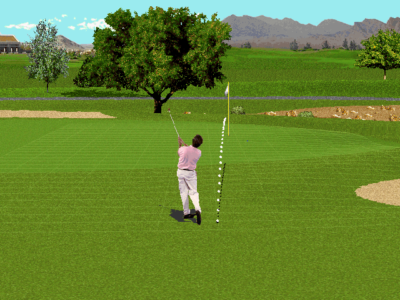
There are two cameras – forward and reverse-angle. A replay gives you this weird ball-tracking graphic, which isn’t that helpful.
On that note, and I’m perfectly willing to admit that I was just being rubbish, I’d say that the meter moves pretty fast even on Novice, and combined with the pressure of each shot and the general high standard of AI opponents, it took me a while to actually win something. On occasion it was possible to do something mildly clever with individual shots, but most of the time I attempted anything too nifty, it went badly wrong and so I reverted to the advice of my pro friend and focused mainly on thunking the ball straight at the hole wherever possible.
Still, while you may not be able to replicate the approach shots of your AI opponents, you can make this up in a couple of ways – firstly, through a solid short game [You don’t know golf, so don’t show off, you mean ‘putting’ – FFG reader], making use of the grid guides and the whispered hints on commentary (although most of the time the commentator seems to think it should either be ‘straight in’ or ‘pretty straight in’) and secondly through chip shots, which seem to be mightily effective for you but not so much for the AI.
So I’d possibly say it was a little on the hard side. There’s also the fact that there are only stand-alone tournaments to be played (you can access career stats for your player, although they’re pretty well hidden) although this was unusual for a sports game at the time. The suspicion also lingers that perhaps it’s a little feature-lite, in terms of available information on each hole, camera views, adjustments to shots etc. Personally, I didn’t really care that much, but David Leadbetter’s Greens, for example, seemed to provide much more in this area – it’s probably the price paid for those impressive (at the time) photo-realistic visuals.
As someone who likes golf enough to occasionally play computer golf but not enough to really delve into the various subtleties and features when he does, I’m perhaps not best equipped to comment on where it stands in history and among contemporaries. (My review of DLG seems to have been predicated on the fact that I’d only ever write about one golf game on here – still, I wasn’t to know we’d still be going 11 years later). I did enjoy PGA 486, though – even if some of that came from whisking me back to the 90s, and allowing me the chance to actually finally play it properly. But, whatever the reasons, it kept me entertained for a good few hours as I worked my way up from missing the cut to winning a tournament. Putting aside any angst over missed shots and being crap, I did still find it a relaxing experience, a good way to while away a quick 30-45 minutes of an evening. And I suddenly feel inspired to delve more into the history of the series and golf games in general.

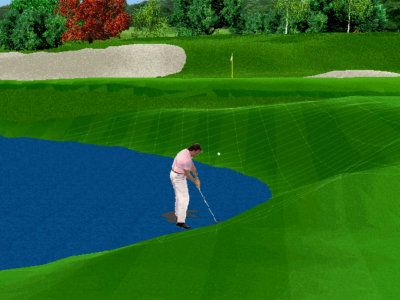
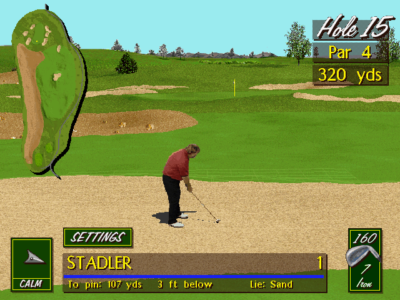
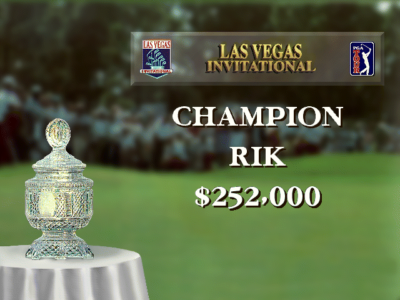

 Posts
Posts